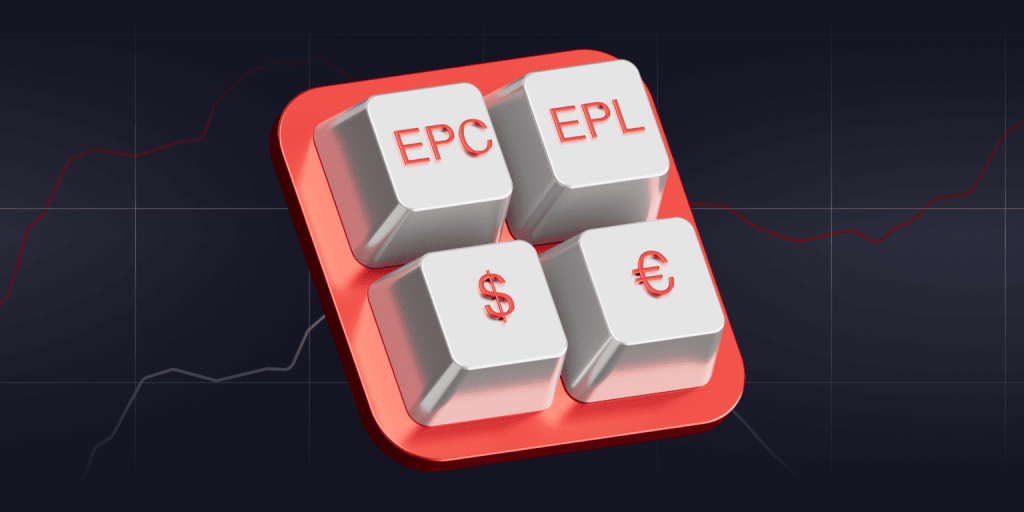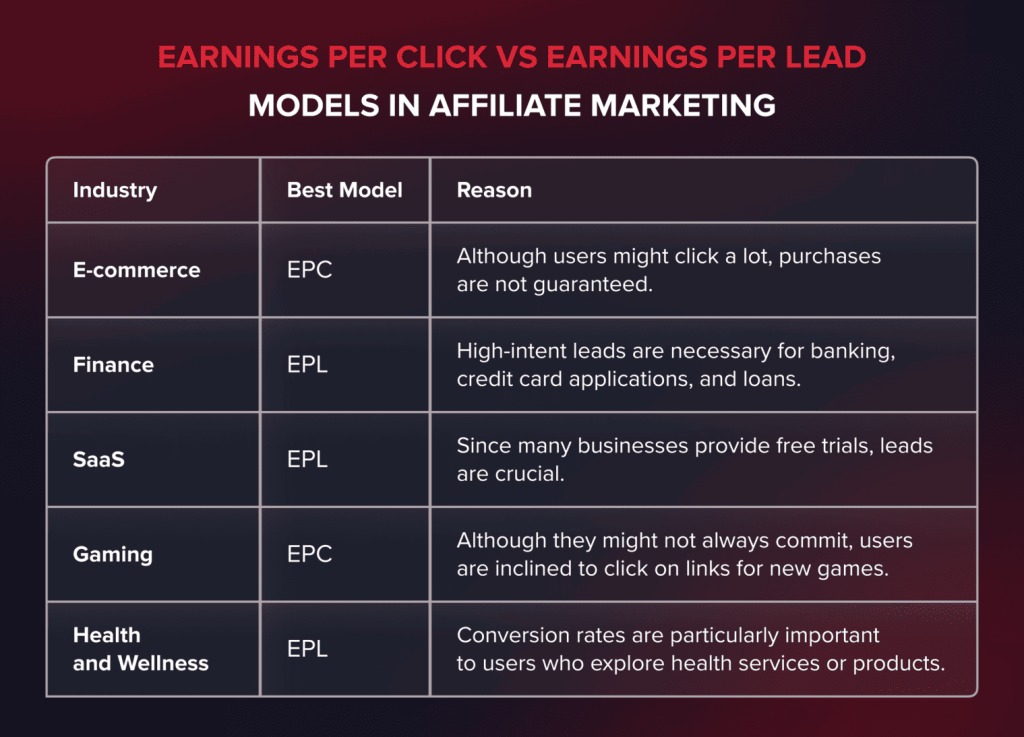
Mô hình Thu nhập trên mỗi lần nhấp (EPC) so với Thu nhập trên mỗi khách hàng tiềm năng (EPL) trong Tiếp thị liên kết
Mục lục
Chìa khóa thành công cho tiếp thị liên kết là đưa ra những lựa chọn đúng đắn về cả sản phẩm bạn quảng bá và cách bạn được trả tiền. Nếu bạn là một nhà tiếp thị liên kết, có lẽ bạn đã nghe nói đến hai mô hình trả thưởng phổ biến: Thu nhập trên mỗi lượt nhấp (EPC) và Thu nhập trên mỗi khách hàng tiềm năng (EPL). Vậy thì, mô hình nào tốt hơn?
Chúng ta hãy bắt đầu với những điều cơ bản:
- Thu nhập trên mỗi lần nhấp chuột, hay EPC, sẽ trả tiền cho bạn mỗi khi người dùng nhấp vào liên kết liên kết của bạn, bất kể họ có mua bất cứ thứ gì hay không.
- Thu nhập trên mỗi khách hàng tiềm năng, hay EPL, chỉ trả tiền cho bạn khi khách truy cập hoàn thành một tác vụ cụ thể, chẳng hạn như điền vào biểu mẫu, đăng ký dịch vụ hoặc đăng ký dùng thử miễn phí. Khoản thanh toán thường đáng kể hơn nhiều so với EPC vì khách hàng tiềm năng cần nhiều công sức hơn để chuyển đổi.
EPL thoạt đầu có vẻ có lợi nhuận hơn, bởi vì xét cho cùng, nhận được 5, 10, thậm chí 50 đô la cho mỗi khách hàng tiềm năng nghe có vẻ tốt hơn nhiều so với việc chỉ nhận được vài xu cho mỗi cú nhấp chuột. Nhược điểm là không phải tất cả lưu lượng truy cập đều chuyển thành khách hàng tiềm năng, vì vậy nếu đối tượng của bạn không sẵn sàng hành động, bạn có thể mất đi doanh thu tiềm năng.
Chúng tôi sẽ khám phá những ưu và nhược điểm của EPC và EPL, phân tích sự khác biệt giữa chúng và hỗ trợ bạn lựa chọn phương án phù hợp nhất với kế hoạch tiếp thị liên kết của mình. Bất kể bạn thích hoa hồng giá trị cao, tập trung vào chuyển đổi hay ưu đãi nhanh chóng, dựa trên khối lượng, chúng tôi cũng sẽ đưa ra lời khuyên hữu ích về cách tối ưu hóa lợi nhuận của bạn.
EPC và EPL là gì?
Mặc dù có nhiều phương pháp kiếm tiền với tiếp thị liên kết, nhưng không phải tất cả các mô hình doanh thu đều hoạt động theo cùng một cách. Thu nhập trên mỗi lượt nhấp (EPC) và Thu nhập trên mỗi khách hàng tiềm năng (EPL), hai trong số những cấu trúc phổ biến nhất, thưởng cho các chi nhánh theo những cách khác nhau, vì vậy điều quan trọng là phải biết phương pháp nào phù hợp nhất với bạn.
- Các chi nhánh sử dụng hệ thống trả thưởng EPC (Thu nhập trên mỗi lượt nhấp) được trả tiền dựa trên số lượt nhấp vào liên kết giới thiệu của họ. Doanh thu của bạn hoàn toàn phụ thuộc vào lượng khách truy cập, vì vậy bạn không cần phải lo lắng về việc những lượt nhấp đó có dẫn đến doanh số hay đăng ký hay không. Phương pháp này đặc biệt hiệu quả với những người có sức ảnh hưởng, blog và trang web thu hút nhiều lưu lượng truy cập nhưng không trực tiếp kiểm soát tỷ lệ chuyển đổi.
- Ngược lại, EPL (Thu nhập trên mỗi khách hàng tiềm năng) dựa trên hiệu suất. Bạn chỉ nhận được hoa hồng khi khách truy cập hoàn thành một hoạt động nhất định, chẳng hạn như điền vào biểu mẫu, đăng ký dịch vụ hoặc tìm kiếm giá, thay vì được trả tiền cho mỗi lần nhấp chuột. Phần thưởng EPL thường cao hơn EPC vì khách hàng tiềm năng đòi hỏi mức độ cam kết của người dùng cao hơn, khiến nó trở thành lựa chọn hàng đầu cho các chi nhánh muốn tiếp cận đối tượng khán giả tích cực.
Chất lượng so với số lượng là sự khác biệt chính giữa hai mô hình này. Trong khi EPL trả tiền cho các chi nhánh có thể thuyết phục khách truy cập thực hiện các hành động quan trọng, EPC cho phép các chi nhánh kiếm tiền từ lưu lượng truy cập mà không cần chuyển đổi. Thị trường ngách, hành vi của đối tượng mục tiêu và chiến lược tiếp thị của bạn sẽ quyết định EPC hay EPL mang lại lợi nhuận cao hơn.
Tiếp theo, chúng ta hãy xem xét kỹ hơn cách thức hoạt động của từng mô hình và cách tính thu nhập tiềm năng của bạn.
EPC so với EPL
Tóm lại, điều quan trọng là phải hiểu rõ Thu nhập trên mỗi lượt nhấp (EPC) và Thu nhập trên mỗi khách hàng tiềm năng (EPL) khác nhau như thế nào về lợi nhuận tiềm năng, nhu cầu lưu lượng truy cập, rủi ro và khả năng sử dụng. Mặc dù hỗ trợ các phương pháp tiếp thị liên kết khác nhau, cả hai mô hình đều có tiềm năng sinh lời rất lớn.
Tiềm năng doanh thu
EPC là một lựa chọn tuyệt vời cho các chi nhánh có lượng truy cập lớn vì nó mang lại lợi nhuận ổn định nhưng thấp hơn trên mỗi người dùng. Các lượt nhấp chuột của khách truy cập vẫn đóng góp vào doanh thu của bạn ngay cả khi họ không mua bất cứ thứ gì. Vấn đề với EPL là không phải mọi lượt nhấp chuột đều dẫn đến một khách hàng tiềm năng đủ điều kiện, mặc dù nó trả phí cao hơn nhiều cho mỗi khách hàng tiềm năng. Sự khác biệt rất rõ ràng: EPL khuyến khích sự tương tác, trong khi EPC phụ thuộc vào khối lượng.
Tập trung chuyển đổi so với lưu lượng truy cập
Mục tiêu của EPC là thu hút càng nhiều khách truy cập càng tốt; càng nhiều người nhấp vào liên kết của bạn, bạn càng kiếm được nhiều tiền. Do đó, đây là mô hình hoàn hảo cho các YouTuber, blogger và người sáng tạo nội dung cung cấp lưu lượng truy cập thụ động. Ngược lại, EPL tập trung vào việc tiếp cận đúng đối tượng, những người dùng đã sẵn sàng hành động. Các nhà tiếp thị qua email, trang web chuyên biệt và các chi nhánh trong các lĩnh vực như ngân hàng hoặc SaaS, nơi khách hàng có nhiều khả năng hoàn thành đăng ký hoặc yêu cầu, là những ứng cử viên phù hợp nhất cho phương pháp này.
You may also like

Cách tính EPC và EPL
Khi nói đến tiếp thị liên kết, các con số tự nói lên tất cả. Thu nhập trên mỗi lượt nhấp (EPC) và Thu nhập trên mỗi khách hàng tiềm năng (EPL) là hai trong số những thước đo quan trọng nhất ảnh hưởng đến thu nhập của bạn. Hiểu cách tính toán những con số này sẽ giúp bạn cải thiện chiến lược và tăng thu nhập, bất kể bạn đang tập trung vào lưu lượng truy cập lớn (EPC) hay chuyển đổi chất lượng cao (EPL).
Cách tính EPC
EPC đo lường số tiền bạn kiếm được từ mỗi lượt nhấp vào liên kết tiếp thị liên kết của mình. Công thức tính toán rất đơn giản:
EPC = Tổng thu nhập: Tổng số lần nhấp chuột
Ví dụ, EPC của bạn sẽ như sau nếu bạn nhận được 200 đô la tiền hoa hồng và 5.000 lượt nhấp vào liên kết liên kết của bạn:
EPC = 200 : 5000 = 0,04
Do đó, bạn kiếm được 0,04 đô la cho mỗi lượt nhấp. Mặc dù con số này có vẻ không nhiều, nhưng các trang web có nhiều lưu lượng truy cập có thể tăng đáng kể thu nhập EPC của họ.
Cách tính EPL
Ngược lại, EPL ưu tiên chuyển đổi hơn nhấp chuột. Nó hiển thị thu nhập của bạn cho mỗi khách hàng tiềm năng thành công. Công thức cho việc này là:
EPL = Tổng thu nhập: Tổng số khách hàng tiềm năng
Ví dụ, nếu bạn kiếm được 500 đô la và tạo ra 100 khách hàng tiềm năng, EPL của bạn sẽ là:
500 : 100 = 5
Do đó, mỗi khách hàng tiềm năng có giá trị 5 đô la. Trong khi EPL thấp hơn có thể cho thấy bạn cần cải thiện chiến thuật nhắm mục tiêu hoặc chuyển đổi, thì EPL cao cho thấy đối tượng của bạn quan tâm và có khả năng hành động.
Tại sao những tính toán này lại quan trọng?
Theo dõi EPC và EPL giúp bạn xác định các chương trình tiếp thị liên kết có lợi nhuận cao nhất. Bạn có thể cần thêm lưu lượng truy cập nếu thu nhập của bạn khiêm tốn mặc dù có EPC cao. Nếu EPL của bạn thấp, bạn có thể cần điều chỉnh các lead magnet và landing page. Bạn phải đạt được sự cân bằng lý tưởng giữa lưu lượng truy cập và chuyển đổi để tối ưu hóa doanh thu tiếp thị liên kết của mình.
Ở phần tiếp theo, chúng ta sẽ xem xét mô hình nào, EPC hay EPL, hoạt động tốt hơn dựa trên đối tượng, phân khúc và chiến lược tiếp thị của bạn.
Mẫu nào phù hợp hơn với bạn?
Không có giải pháp nào phù hợp cho tất cả mọi người khi lựa chọn giữa Thu nhập trên mỗi lượt nhấp (EPC) và Thu nhập trên mỗi khách hàng tiềm năng (EPL). Mô hình tốt nhất sẽ khác nhau tùy thuộc vào lĩnh vực, đối tượng và chiến lược tiếp thị của bạn. Nhắm mục tiêu đến những người dùng có mức độ tương tác cao, sẵn sàng chuyển đổi là cách một số chi nhánh phát triển mạnh mẽ, trong khi những chi nhánh khác lại thành công nhờ lượng truy cập lớn.
Mô hình tốt nhất dựa trên chiến lược liên kết
Kế hoạch tiếp thị liên kết nào sẽ mang lại cho bạn thu nhập lớn nhất chủ yếu phụ thuộc vào chiến lược của bạn.
- Nếu bạn là người có sức ảnh hưởng trên mạng xã hội, YouTuber hoặc blogger. Mặc dù rất nhiều người dùng các nền tảng này, nhưng không phải ai cũng sẵn sàng mua hàng hoặc đăng ký. Ngay cả khi người dùng chỉ nhấp chuột mà không chuyển đổi, EPC vẫn đảm bảo bạn vẫn được trả tiền.
- Nếu bạn tập trung vào tiếp thị qua email, bán hàng trực tiếp hoặc cộng đồng ngách, EPL là lựa chọn tốt hơn. Làm việc với đối tượng mục tiêu tích cực sẽ tăng khả năng họ thực hiện hành động (đăng ký, tìm kiếm báo giá, v.v.), từ đó tăng phần thưởng cho mỗi khách hàng tiềm năng.
Mô hình tốt nhất dựa trên chất lượng giao thông
Mỗi loại lưu lượng truy cập đều khác nhau. Bạn có thể chọn mô hình tốt nhất nếu biết rõ khách truy cập của mình là ai và họ muốn gì.
- Nếu đối tượng của bạn bao gồm những người ít duyệt web, người dùng mạng xã hội hoặc những người tìm kiếm thông tin chung chung, EPC là một lựa chọn an toàn hơn. Vì tò mò, những người dùng này có thể sẽ nhấp vào liên kết, nhưng không phải tất cả đều sẽ tiếp tục. Ngay cả khi họ không chuyển đổi, bạn vẫn có thể hưởng lợi từ sự quan tâm của họ với EPC.
- Nếu đối tượng của bạn bao gồm các chuyên gia, khách hàng hoặc cá nhân đang tích cực tìm kiếm câu trả lời, EPL sẽ mang lại lợi nhuận cao hơn. Hoa hồng trên mỗi khách hàng tiềm năng cao hơn đến từ việc những người dùng này sẵn sàng đăng ký dùng thử, sử dụng dịch vụ hoặc đặt câu hỏi.
Mô hình tốt nhất dựa trên thị trường ngách và ngành công nghiệp
Trong khi một số ngành hoạt động tốt nhất với EPL, một số ngành khác lại phù hợp hơn với EPC. Dưới đây là tóm tắt ngắn gọn về các mô hình hiệu suất cao nhất trong một số ngành:

Mẫu nào phù hợp nhất với bạn?
EPC là lựa chọn tốt nhất nếu bạn có nhiều lưu lượng truy cập nhưng ít chuyển đổi. EPL sẽ tăng hoa hồng nếu bạn có thể thu hút những khách truy cập có ý định và tương tác cao đăng ký hoặc thực hiện hành động. Một số chi nhánh thậm chí còn kết hợp cả hai chiến lược, tập trung vào EPL cho các dịch vụ có giá trị cao và sử dụng EPC để kiếm tiền từ lưu lượng truy cập thông thường.
Để tận dụng tối đa các nỗ lực liên kết của bạn bất kể mô hình nào bạn chọn, bây giờ chúng ta hãy khám phá các kỹ thuật để tối ưu hóa lợi nhuận ở cả EPC và EPL.
Tối đa hóa lợi nhuận: Mẹo cho EPC và EPL
Bí quyết để tối ưu hóa lợi nhuận tiếp thị liên kết của bạn nằm ở chiến lược và sự tối ưu hóa, bất kể bạn đang sử dụng lợi nhuận trên mỗi lượt nhấp (EPC) hay Thu nhập trên mỗi khách hàng tiềm năng (EPL). Hoa hồng của bạn có thể tăng đáng kể bằng cách điều chỉnh cách bạn tương tác với đối tượng mục tiêu, sắp xếp nội dung và quảng bá các ưu đãi. Dưới đây là một số mẹo để tận dụng tối đa cả hai mô hình.
Chiến lược tăng lợi nhuận EPC
Mục tiêu của việc sử dụng EPC là tạo ra càng nhiều lượt nhấp chuột chất lượng cao càng tốt. Tuy nhiên, một số lượt nhấp chuột có tỷ lệ chuyển đổi tốt hơn những lượt nhấp chuột khác; do đó, không phải tất cả đều giống nhau. Hãy tập trung vào các chiến lược sau để tăng thu nhập EPC của bạn:
- Chọn các chương trình liên kết có lợi nhuận - Tỷ lệ EPC ở một số mạng lưới và lĩnh vực cụ thể cao hơn những nơi khác. Hãy tìm hiểu các lựa chọn cao cấp mang lại mức hoa hồng cao hơn cho mỗi lần nhấp chuột thay vì các chương trình trả phí thấp như Amazon Associates.
- Tăng tỷ lệ nhấp chuột (CTR) càng cao càng tốt - Nếu liên kết tiếp thị liên kết của bạn không nổi bật, người xem sẽ không nhấp chuột. Để tăng lượt nhấp, hãy sử dụng các nút kêu gọi hành động (CTA) thu hút sự chú ý, tiêu đề hấp dẫn và ngôn ngữ thuyết phục.
- Tiến hành thử nghiệm A/B trên các liên kết tiếp thị liên kết và trang đích - Không phải vị trí nào cũng hiệu quả như nhau. Hãy thử nghiệm màu sắc nút, kiểm tra các vị trí đặt liên kết khác nhau và xác định vị trí nào thu hút người dùng nhất.
- Tận dụng lưu lượng truy cập được tài trợ và quảng cáo gốc - Với sự trợ giúp của các nền tảng như Google Ads và Facebook Ads, bạn có thể mở rộng lưu lượng truy cập và tăng lượt nhấp chuột, từ đó tăng toàn bộ doanh thu. Để đạt được lợi tức đầu tư tốt nhất, hãy đảm bảo bạn nhắm mục tiêu đúng đối tượng.
You may also like

Chiến lược tăng lợi nhuận EPL
EPL đòi hỏi một chiến lược khác - ở đây, việc thu hút lượt nhấp chuột không phải là mục tiêu duy nhất; việc khiến người dùng hành động cũng rất quan trọng. Hoa hồng của bạn sẽ tăng theo mức độ tương tác và chất lượng của khách hàng tiềm năng. Dưới đây là cách cải thiện hiệu suất của bạn trong EPL:
- Xây dựng uy tín và sự tin tưởng - Nếu mọi người tin vào lời khuyên của bạn, họ sẽ có nhiều khả năng tham gia sử dụng dịch vụ hơn. Để chứng minh giá trị của sản phẩm hoặc dịch vụ, hãy sử dụng các bài đánh giá chuyên sâu, nghiên cứu điển hình và lời chứng thực của khách hàng.
- Cải thiện trang đích để tăng tỷ lệ chuyển đổi - Trang đích của bạn nên gọn gàng, thuyết phục và dễ hiểu. Để tăng lượng đăng ký, hãy đảm bảo biểu mẫu ngắn gọn và dễ hiểu, nhấn mạnh lợi ích hơn tính năng và tận dụng bằng chứng xã hội mạnh mẽ.
- Sử dụng chiến lược tiếp thị lại và tiếp thị qua email - Không phải ai cũng chuyển đổi ngay lần truy cập đầu tiên. Để nhắc nhở người dùng về ưu đãi, hãy ghi lại email và gửi thông tin tiếp theo. Quảng cáo tiếp thị lại trên các trang web như Facebook và Google cũng có thể thu thập khách hàng tiềm năng.
- Hợp tác với các công ty cung cấp tính năng theo dõi đa điểm chạm. Một số khách hàng tiềm năng mất một thời gian để chuyển đổi; nếu họ quay lại sau đó, bạn sẽ không muốn mất hoa hồng. Hãy chọn các công cụ cung cấp tính năng theo dõi cookie và phân bổ đa điểm chạm để đảm bảo bạn nhận được hoa hồng cho mỗi khách hàng tiềm năng bạn tạo ra.
Cho dù bạn tập trung vào lượt nhấp chuột, khách hàng tiềm năng hay kết hợp cả hai, bạn đều có thể tăng đáng kể thu nhập tiếp thị liên kết bằng cách áp dụng những ý tưởng này. Bước tiếp theo là gì? Để tối ưu hóa thành công lâu dài trong tiếp thị liên kết, hãy thử nghiệm, phân tích và liên tục cải thiện chiến lược của bạn.
Lời kết
Quyết định giữa Thu nhập trên mỗi lượt nhấp (EPC) và Thu nhập trên mỗi khách hàng tiềm năng (EPL) cuối cùng phụ thuộc vào việc hiểu rõ thị trường mục tiêu, mục tiêu của bạn và loại lưu lượng truy cập bạn thu hút. EPC là một nguồn thu nhập ổn định và đáng tin cậy nếu chuyên môn của bạn là nội dung có khối lượng lớn, chẳng hạn như blog, mạng xã hội hoặc nền tảng video tạo ra nhiều lượt nhấp nhưng ít chuyển đổi trực tiếp. Tuy nhiên, EPL sẽ mang lại nhiều hoa hồng hơn cho mỗi tương tác nếu bạn đã phát triển được một đối tượng mục tiêu tập trung và năng động hơn, sẵn sàng thực hiện các hành động cụ thể, chẳng hạn như đăng ký, đăng ký hoặc gửi câu hỏi.
Bí quyết là bạn không nhất thiết phải chọn một. Thử nghiệm cả hai phương pháp, xem xét kỹ lưỡng kết quả và dần dần điều chỉnh chiến lược là cách mà nhiều nhà tiếp thị liên kết thành công.
Chiến lược tích hợp này giúp bạn giảm bớt sự phụ thuộc vào một nguồn thu nhập duy nhất, đồng thời tối ưu hóa tiềm năng kiếm tiền. Việc tối ưu hóa nhất quán, theo dõi sát sao và thử nghiệm liên tục là những yếu tố then chốt cho bất kỳ mô hình nào bạn lựa chọn. Hãy nhớ rằng những nhà tiếp thị thành công nhất là những người có tư duy chiến lược, luôn tìm cách cải thiện bản thân, chứ không chỉ là những người làm tiếp thị. Vì vậy, hãy bắt đầu thử nghiệm, tiếp tục học hỏi và quan sát sự tăng trưởng trong thu nhập tiếp thị của bạn!
Đã cập nhật:
4 tháng 4, 2025





